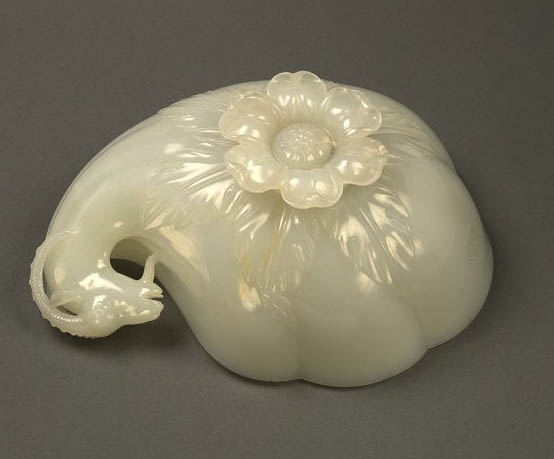Wine cup of Shah Jahan on:
[Wikipedia]
[Google]
[Amazon]
 The wine cup of Shah Jahan is a wine cup of white nephrite jade that was made for the Mughal emperor Shah Jahan.
The cup has a gourd shape like in a paisley design. The handle is shaped like the head of a ram. The bottom features acanthus leaves and a lotus flower, which is the pedestal. The cup is inscribed with his title, "Second Lord of the Conjunction", following the conventions of royal titulature in the Persian-speaking world. It specifically alludes to
The wine cup of Shah Jahan is a wine cup of white nephrite jade that was made for the Mughal emperor Shah Jahan.
The cup has a gourd shape like in a paisley design. The handle is shaped like the head of a ram. The bottom features acanthus leaves and a lotus flower, which is the pedestal. The cup is inscribed with his title, "Second Lord of the Conjunction", following the conventions of royal titulature in the Persian-speaking world. It specifically alludes to
Victoria and Albert Museum, Wine cup of Shah Jahan
{{Wines Asian objects in the Victoria and Albert Museum Mughal art Red Fort Wine accessories Individual hardstone carvings Indian wine 17th century in India
 The wine cup of Shah Jahan is a wine cup of white nephrite jade that was made for the Mughal emperor Shah Jahan.
The cup has a gourd shape like in a paisley design. The handle is shaped like the head of a ram. The bottom features acanthus leaves and a lotus flower, which is the pedestal. The cup is inscribed with his title, "Second Lord of the Conjunction", following the conventions of royal titulature in the Persian-speaking world. It specifically alludes to
The wine cup of Shah Jahan is a wine cup of white nephrite jade that was made for the Mughal emperor Shah Jahan.
The cup has a gourd shape like in a paisley design. The handle is shaped like the head of a ram. The bottom features acanthus leaves and a lotus flower, which is the pedestal. The cup is inscribed with his title, "Second Lord of the Conjunction", following the conventions of royal titulature in the Persian-speaking world. It specifically alludes to Timur
Timur ; chg, ''Aqsaq Temür'', 'Timur the Lame') or as ''Sahib-i-Qiran'' ( 'Lord of the Auspicious Conjunction'), his epithet. ( chg, ''Temür'', 'Iron'; 9 April 133617–19 February 1405), later Timūr Gurkānī ( chg, ''Temür Kü ...
, the central Asian ruler from whom the Mughals were descended. The artist who created the cup is unknown.
The cup is dated 1067 of the Islamic calendar, and regnal year 31, which convert to 1657 CE. The place of production was India. The length is 18.7 cm and width 14 cm. It was acquired in the 19th century by Colonel Charles Seton Guthrie, most probably after the Indian rebellion of 1857
The Indian Rebellion of 1857 was a major uprising in India in 1857–58 against the rule of the British East India Company, which functioned as a sovereign power on behalf of the British Crown. The rebellion began on 10 May 1857 in the fo ...
. It was formerly in the possession of R. M. W. Walker, on whose death it was sold by Christie & Co (12/7/1945, lot 146) and passed from the purchasers, Messrs Spink, to Queen Maria of Yugoslavia
Maria of Yugoslavia (born Princess Maria of Romania; 6 January 1900 – 22 June 1961), known in Serbian as Marija Karađorđević ( sr-cyr, Марија Карађорђевић), was Queen of the Serbs, Croats and Slovenes, later Queen of Yugo ...
. It again came into the hands of Spink, who then sold it to Mr Lazarus, who discovered the inscription and sold it back to the vendors. It was acquired by the Victoria and Albert Museum
The Victoria and Albert Museum (often abbreviated as the V&A) in London is the world's largest museum of applied arts, decorative arts and design, housing a permanent collection of over 2.27 million objects. It was founded in 1852 and nam ...
in 1962.
Further reading
* Swallow, Deborah and John Guy eds. Arts of India: 1550-1900. Text by Rosemary Crill, John Guy, Veronica Murphy, Susan Stronge and Deborah Swallow. London : V&A Publications, 1990, pp. 94-95, ill. no. 73. * Robert Skelton, The Shah Jahan cup, V&A Masterpiece leaflet * Susan Stronge, 'Colonel Guthrie's Collection', Oriental Art, vol. XXXIX, no. 4, 1993-4, fig. 1 p. 5. * Rosemary Crill, in The Indian Heritage. Court Life and Arts under Mughal Rule, V&A, 1982, cat. 318, p.111, .See also
*Wine accessory
Wine accessories are things that may be used in the storage or serving of wine. Wine accessories include many items such as wine glasses, corkscrews, and wine racks.
Glasses
Wine glasses are a type of glass stemware that are used to drink and ...
*Wine tasting
Wine tasting is the sensory examination and evaluation of wine. While the practice of wine tasting is as ancient as its production, a more formalized methodology has slowly become established from the 14th century onward. Modern, professional w ...
References
External links
Victoria and Albert Museum, Wine cup of Shah Jahan
{{Wines Asian objects in the Victoria and Albert Museum Mughal art Red Fort Wine accessories Individual hardstone carvings Indian wine 17th century in India